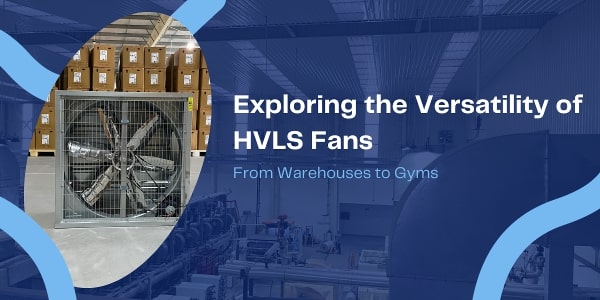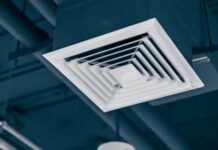Imagine a summer day in a vast warehouse where the air feels stagnant, and the heat seems inescapable. Now, picture the same space, but this time, with a gentle, cooling breeze that seems to come from nowhere. This transformation is made possible by a relatively unsung hero of industrial and commercial spaces: HVLS fans. These fans are not your typical ceiling fans. They are giants, often spanning over 24 feet in diameter, moving massive volumes of air at a slow, gentle pace. In this article, we’ll delve into the versatility of HVLS fans, focusing primarily on their applications in warehouses and gyms, showcasing how they are redefining comfort and efficiency in large spaces.


The Science Behind HVLS Fans
HVLS fans operate on a simple yet ingenious principle: move a large amount of air slowly rather than a small amount quickly. This approach maximizes air movement in large spaces, creating a consistent airflow that can span vast areas with minimal energy consumption. The science of these fans lies in their design; their large blades move significantly with each rotation, resulting in efficient air circulation even at low speeds.
Take, for instance, the story of Mike, a warehouse manager. “Before installing HVLS fans, we struggled with air stagnation and hotspots,” Mike recalls. “But once we got these fans running, it was like night and day. The constant air movement made the entire space feel more comfortable, and our energy bills decreased, too!”
HVLS Fans in Warehouses
In the context of warehouses, proper ventilation is more than a matter of comfort; it’s a necessity for both the preservation of goods and the well-being of workers. HVLS fans excel in these environments by providing effective temperature regulation and improving air quality. Their ability to destratify air (warm air at the ceiling with cooler air at the floor) is particularly beneficial in maintaining consistent temperatures throughout the warehouse.
A case study from a distribution center in Texas highlights this benefit. After installing HVLS fans, the center reported a 4-degree reduction in perceived temperature during summer, significantly enhancing employee comfort and productivity.
Benefits of HVLS Fans in Warehouses
Improved Air Circulation: HVLS fans excel in circulating large volumes of air throughout expansive warehouse spaces. This helps maintain consistent air quality and temperature, which is essential for storing various goods, especially those sensitive to temperature fluctuations.
Energy Efficiency: By efficiently circulating air, HVLS fans reduce the need for HVAC systems to work as hard, leading to significant energy savings. This is particularly beneficial in large warehouses with substantial heating and cooling costs.
Enhanced Worker Comfort: Comfortable employees are more productive. HVLS fans help maintain a more consistent temperature, reducing the discomfort caused by extreme temperatures. This can lead to reduced fatigue, stress, and improved working conditions for warehouse staff.
Reduced Humidity: In many warehouse environments, humidity can be a problem, leading to moisture-related damage to goods. HVLS fans help circulate air and reduce humidity levels, protecting the integrity of stored products.
Cost-Effective: Compared to installing multiple smaller fans or extensive HVAC systems, HVLS fans offer a cost-effective solution for large spaces like warehouses in terms of installation and long-term operational costs.
HVLS Fans in Gyms
With their high ceilings and large open areas, Gyms are another ideal setting for HVLS fans. Air quality and temperature control are crucial for comfort and health in these spaces. HVLS fans help circulate fresh air, reducing the buildup of odors and humidity often associated with gym environments.
A gym owner, Hardcore, shares her experience: “Our members immediately noticed the difference. The fans created a fresh, breezy environment, making workouts more enjoyable. And the reduced need for air conditioning helped us cut energy costs.”
Benefits of HVLS Fans in Gyms
Enhanced Air Quality: With high-intensity activities, gyms need adequate air circulation to maintain air quality. HVLS fans help disperse and dilute airborne contaminants, reducing the risk of airborne diseases.
Improved Thermal Comfort: During workouts, gym-goers generate body heat, raising the indoor temperature. HVLS fans help create a more comfortable environment by providing a cooling effect and maintaining a consistent temperature.
Energy Savings: Similar to warehouses, gyms can also benefit from the energy efficiency of HVLS fans. They complement HVAC systems, allowing for reduced air conditioning usage and lower energy bills.
Noise Reduction: HVLS fans operate quietly compared to multiple smaller fans. This is crucial in gym environments where excessive noise can distract or disrupt the workout experience.
Space-Saving Design: Given their size and efficiency, fewer HVLS fans are needed to cover a large area. This is particularly beneficial in gyms where space optimization is critical.
Comparing HVLS Fans with Traditional Fans
HVLS fans stand out in efficiency and cost-effectiveness compared to traditional fans. Classic fans, often smaller and faster, can’t match HVLS fans’ area coverage and gentle breeze effect. Moreover, HVLS fans are more energy-efficient, translating to significant cost savings in the long run.
Efficiency
● HVLS Fans: HVLS fans are highly efficient in slowly moving large volumes of air, making them ideal for large, open spaces. They create a deep, enveloping column of air that flows down and out along the floor, covering a vast area effectively. This efficiency translates into better air circulation and temperature regulation in large spaces.
● Traditional Fans: Traditional fans, typically smaller and faster, are more suitable for localized cooling. They are less efficient in large rooms as they cannot move air over long distances or cover large areas as effectively as HVLS fans.
Cost-Effectiveness
● HVLS Fans: In the long run, HVLS fans are more cost-effective, especially for large spaces. They consume less energy than running multiple traditional fans to achieve the same level of air circulation. Additionally, they can reduce the load on heating and cooling systems, leading to further cost savings.
● Traditional Fans: While the initial cost of conventional fans is generally lower, they may be less cost-effective for large spaces. They often require more units to cover the same area and consume more energy when used in high numbers.
Performance in Different Environments
● HVLS Fans: Designed for large, open areas such as warehouses, gyms, and commercial spaces, HVLS fans maintain consistent air quality and temperature across expansive regions. Their slow, steady air movement is less disruptive and more comfortable in such settings.
● Traditional Fans: Traditional fans are more suitable for smaller, confined spaces requiring targeted airflow. They can be effective in personal rooms, offices, or residential areas where a direct, localized breeze is desirable.
Airflow and Comfort
● HVLS Fans: The airflow created by HVLS fans is more uniform and far-reaching. It feels more natural and gentle, akin to a soft, cooling breeze rather than a forceful gust of wind. This makes HVLS fans ideal for settings where a consistent and comfortable indoor climate is necessary.
● Traditional Fans: The airflow from classic fans is more concentrated and direct, which can be more desirable in specific situations but may be uncomfortable over extended periods, especially in large open spaces.
Noise Levels
● HVLS Fans: HVLS fans tend to operate quietly, making them suitable for environments where noise levels are a concern, such as workplaces or gyms.
● Traditional Fans: Depending on the model, classic fans can be noisier, especially at higher speeds, which might be distracting or undesirable in some settings.
An expert in industrial ventilation explains, “HVLS fans are a game-changer for large spaces. Their operational cost is just a fraction of what you would spend on running multiple high-speed fans, and the comfort level they provide is unparalleled.”
Conclusion
HVLS fans are a testament to the power of innovative design and technology in transforming large spaces like warehouses and gyms. Their versatility, efficiency, and effectiveness in enhancing comfort and air quality make them an excellent choice for any ample space. As we look to the future, the role of HVLS fans in sustainable and comfortable building design seems not just promising but essential. We encourage readers to consider the many benefits of HVLS fans for their spaces, embracing a future where comfort and efficiency go hand in hand.
























